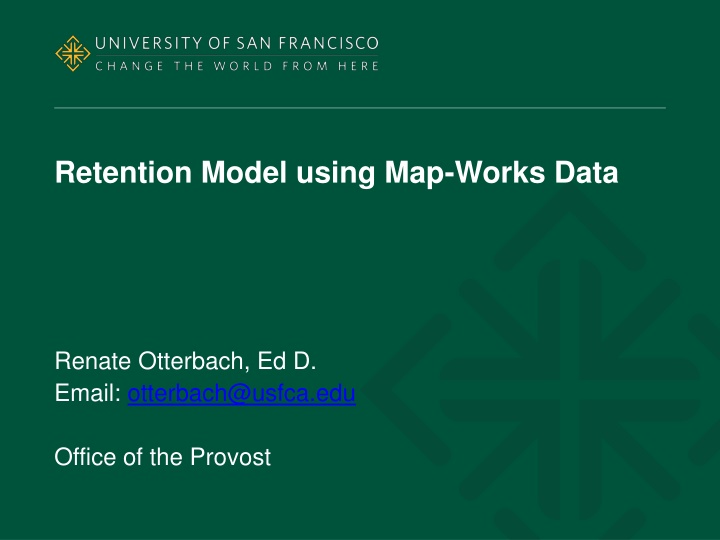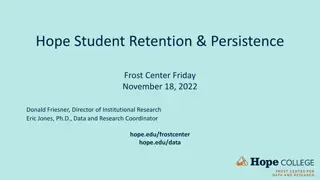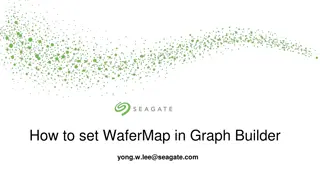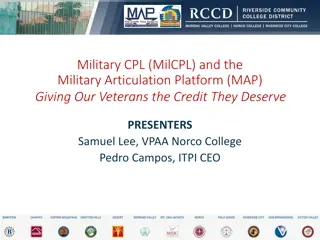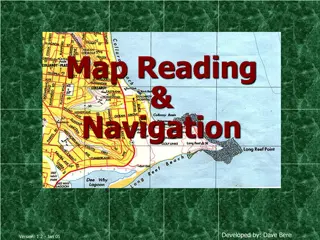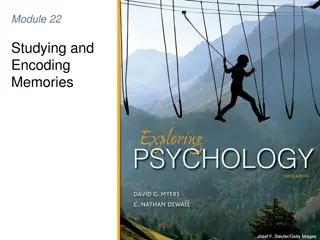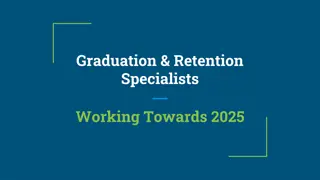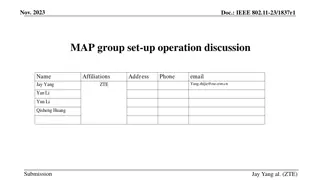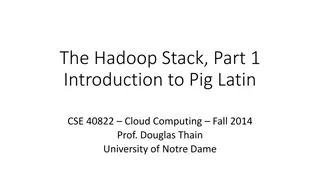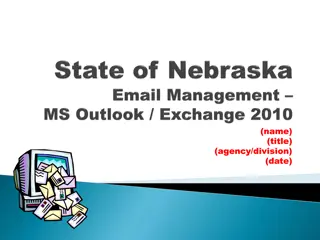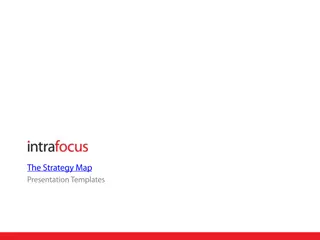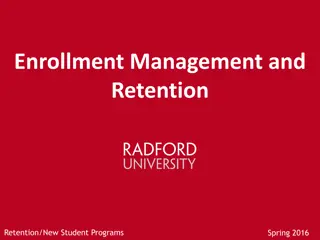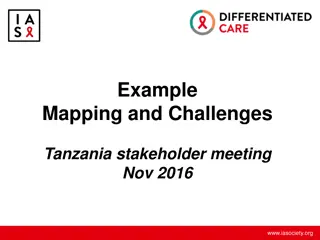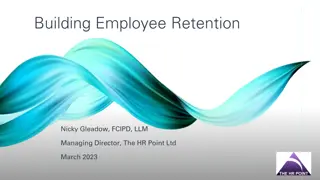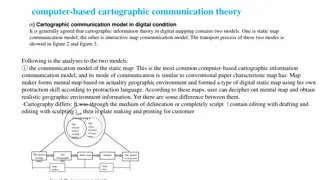Retention Model using Map-Works Data
Utilizing Map-Works data, Dr. Renate Otterbach provides insights and strategies to enhance student retention in higher education. Her expertise from the Provost's office focuses on improving educational outcomes and support services for students.
Download Presentation

Please find below an Image/Link to download the presentation.
The content on the website is provided AS IS for your information and personal use only. It may not be sold, licensed, or shared on other websites without obtaining consent from the author.If you encounter any issues during the download, it is possible that the publisher has removed the file from their server.
You are allowed to download the files provided on this website for personal or commercial use, subject to the condition that they are used lawfully. All files are the property of their respective owners.
The content on the website is provided AS IS for your information and personal use only. It may not be sold, licensed, or shared on other websites without obtaining consent from the author.
E N D
Presentation Transcript
Retention Model using Map-Works Data Renate Otterbach, Ed D. Email: otterbach@usfca.edu Office of the Provost
Purpose To understand the first-year student experience: by identifying pertinent variables for retention by identifying ways to maximize the effectiveness of student services
Method Used and Rationale for Methodology Qualitative data analysis was used to explore these issues because: Qualitative data provides insight into students expectations, perceptions, and aspirations Qualitative data can be used for building inductive theoretical models
Data Data: Two questions from Map-Works data were used: What do you like most about college? What do you like least about college? Population: 1600 respondents
Overview of Methodology 1. The data set was imported into NVivo 2. A word frequency count was run (WC) 3. All data (2012) were coded using open coding (SC) 4. The responses of each node were then sorted by related constructs and similarity of language 5. Memo writing was used to capture the key relationships among the comments. (MW) 6. Finally the data was integrated into one model (MM) 7. Literature was used to amplify and clarify different aspect of the Model (Initials) are hyperlinks to examples To return to main PowerPoint from the actual model use
Methodology continue 8. In addition, a comparison of the responses to questions like most/least by the same students indicated that there may be interaction effect between the academic and social aspects. CC 9. Two quantitative indicators in the Map-Works data academic and social integration and were identified as potential variables verify these findings quantitatively using the data and the retention rates of 2012 (AC)
Sample of Categories Friends/Peers home International students learning mission off-campus opportuniities other People professors_teachers Reflection self-knowledge responsibility roommate schedule size social life stress academics activities athletics Campus City classes community cost courses diversity dorm dorm rules policies environment food Freedom/Independence
Sample Memo Activities Positive The variety and the diversity of activities were mentioned several times and were positively compared to high school. Two activities that were specifically mentioned were the welcome weekend and the adventure at Koret. Two students also specifically mentioned the gym as something they liked most, while one student mentioned the activities of the SI institute and one student was anticipating the freshmen seminar excursing with excitement. Another student mentioned that the multiple organizations and clubs provided a taste of the real world. As some of the students mentioned, variety of activities provide students with the ability to get involved in something that they love to do and provide them with an opportunity to socialize. (SN)
Sample Memo Activities Negative The majority of students who choose activities in the "dislike the most" response were not so much concerned about a lack of activities (although there was a student who mentioned that) but rather were unsure what they wanted to get involved in, either they do not know or found the number of choices overwhelming.
General Conceptual Model of the College Experience Premise: Students come to college to obtain an education and transition to adult life Input Outcomes (connected to WASC and Learning outcomes as applicable see hyperlink) Academic Competence: Life long learning careers Model of student entry characteristics (HL) Interpersonal Competence: Ability to develop and sustain healthy social networks and friendships Ability to communicate effectively with people on personal and professional level Ability to function effectively in a multicultural, ethnical diverse environment Interaction between students and college Model of structure and planned experiences that the university provides for students to obtain their educational goal (HL) Model of structure and planned experiences that the university provides for students to obtain their educational goal (HL) Intrapersonal Competence: Ability to function as a mature, independent adult To navigate the model: The house returns you to this page. Objects with (HL) are hyperlinked the next level (similar to drilldown). The first two buttons are the detail model for the above input variables. The buttons with the yellow writing navigate the students journey model and the buttons with the white writing navigate the campus model. The return arrow key will return you to the PowerPoint. + and - Intrapersonal skills + and -Academics + and - : Academics environment + and - : Student social environment + and - : Student social environment Student journey model: Main model Student journey model: Main model Campus services model: Main model Campus services model: Main model + and physical environment + and - : interpersonal skills + and - Intrapersonal skills + and - Academics + and - : Academics environment + and physical environment + and - : interpersonal skills
Retention model based on students ability to adapt to the college environment Student Input Incoming Level of Academic Skill (HL) Incoming Level of Academic Skill (HL) Retained Short Areas of change/ Adjustment (HL) Areas of change/ Adjustment (HL) Incoming Level of Social Skill (Interpersonal) (HL) Incoming Level of Social Skill (Interpersonal) (HL) Long Incoming Level of Maturity (Intrapersonal) (HL) Not Retained Incoming Level of Maturity (Intrapersonal) (HL) Ability to Adjust (currently not measured) Ability to Adjust (currently not measured) + and - Intrapersonal skills + and -Academics + and - : Academics environment + and - : Student social environment + and - : Student social environment Student journey model: Main model Student journey model: Main model Campus services model: Main model Campus services model: Main model + and physical environment + and - : interpersonal skills + and - Intrapersonal skills + and - Academics + and - : Academics environment + and physical environment + and - : interpersonal skills
Retention model based on students perception of the quality of services/assistance we provide Student come to college for the purpose of obtaining an education USF provides the structure and planned experiences for students to obtain their goal: Environment (overview) City Campus Dorm environment Food Academics (overview) Faculty Classes Instruction Schedule Courses Class size Students social environment (overview) Student social interaction in dorms Events Involvement (general) Academic and Social integrated Freshmen seminars/Muscat scholars/LLC s Clubs and organizations Sports/Athletics Attrition (the part we can influence and excluding university withdrawal) is either students evaluation that the cost was not worth the benefits because: Tuition is the value we place on the services we provide the value of education is not worth the price they are paying Or The education may be worth the price but the long-term liabilities of repayment are not Student journey model: Main model Student journey model: Main model Campus services model: Main model Campus services model: Main model + and -Academics + and - : interpersonal skills + and - : Academics environment + and - : Student social environment + and - : Student social environment + and - Intrapersonal skills + and physical environment + and - Academics + and - : interpersonal skills + and - : Academics environment + and - Intrapersonal skills + and physical environment
Incoming Levels of Academics (Qualitative) The Change from the familiar home environment to the unfamiliar college environment Learning Opportunities Studying Academics Studying Challenges Studying Student journey model: Main model Student journey model: Main model Campus services model: Main model Campus services model: Main model + and -Academics + and - : interpersonal skills + and - : Academics environment + and - : Student social environment + and - : Student social environment + and - Intrapersonal skills + and physical environment + and - Academics + and - : interpersonal skills + and - : Academics environment + and - Intrapersonal skills + and physical environment
Interpersonal Skills: Opportunities Creating community, developing a sense of belonging Opportunities for: Developing meaningful personal relationships Developing and social network Enriching one s interpersonal relationships through diversity Interpersonal skills Creating community, developing a sense of belonging Challenges To: Developing meaningful personal relationships Developing and social network Student journey model: Main model Student journey model: Main model Campus services model: Main model Campus services model: Main model + and -Academics + and - : interpersonal skills + and - : Academics environment + and - : Student social environment + and - : Student social environment + and - Intrapersonal skills + and physical environment + and - Academics + and - : interpersonal skills + and - : Academics environment + and - Intrapersonal skills + and physical environment
Incoming Levels of Intrapersonal Skills Independence Maturation, growth, autonomy Opportunities for : Interdependence Intrapersonal (Maturity) Identity development Intrapersonal (Maturity) Independence Challenges to: Maturation, growth, autonomy Maturation, growth, autonomy Identity development + and - Intrapersonal skills + and physical environment + and - : interpersonal skills + and -Academics + and - : Academics environment + and - : Student social environment + and - : Student social environment Student journey model: Main model Student journey model: Main model Campus services model: Main model Campus services model: Main model + and - Intrapersonal skills + and physical environment + and - : interpersonal skills + and - Academics + and - : Academics environment
Intrapersonal Skills: Challenges Growth and Maturation Not feeling in control of one s own life, resources Not being able to define one s, goals career and interest Lack of skills or opportunity to define one s own path and plan one s life, not being able to define one s, goals career and interest Not being able to structure one s life around one s values- or not knowing one s values Growth and maturation Difficulty making decisions or making the right decisions Difficulties in planning one s live setting priorities, balancing multiple demands one one s time and resources Difficulty with accepting or managing responsibilities for one s choices and actions Student journey model: Main model Student journey model: Main model Campus services model: Main model Campus services model: Main model + and -Academics + and - : interpersonal skills + and - : Academics environment + and - : Student social environment + and - : Student social environment + and - Intrapersonal skills + and physical environment + and - Academics + and - : interpersonal skills + and - : Academics environment + and - Intrapersonal skills + and physical environment
Areas of adjustment: Challenges Adjustment (challenges) Adjusting to a different academic environment Adjusting to living in the dorm Adjusting to leaving home and dealing with feelings of isolation Areas of change/ adjustment Adjusting to a different environment Adjusting to a different social/interpersonal environment Adjusting to being around/living with people of different values Difficulty with adjusting to change Student journey model: Main model Student journey model: Main model Campus services model: Main model Campus services model: Main model + and -Academics + and - : interpersonal skills + and - : Academics environment + and - : Student social environment + and - : Student social environment + and - Intrapersonal skills + and physical environment + and - Academics + and - : interpersonal skills + and - : Academics environment + and - Intrapersonal skills + and physical environment
USFs Structure and Planned Experiences City Campus Opportunities Dorms physical environment Food Environment City and urban living Campus Dorms physical environment Food Challenges Student journey model: Main model Student journey model: Main model Campus services model: Main model Campus services model: Main model + and -Academics + and - Intrapersonal skills + and - : Academics environment + and - : Student social environment + and - : Student social environment + and - : interpersonal skills + and physical environment + and - Academics + and - Intrapersonal skills + and - : Academics environment + and - : interpersonal skills + and physical environment
USF Structure/Planned Experiences: Academics Faculty Courses selection Opportunities Schedule Class Size Classes Challenges Schedule Challenges Academics Classes School/Classes Challenges Other Academically related Challenges Other Interfering with other areas Academically related Challenges Worries/Concerns Quality of Program Others Student journey model: Main model Student journey model: Main model Campus services model: Main model Campus services model: Main model + and - Intrapersonal skills + and -Academics + and - : Academics environment + and - : Student social environment + and - : Student social environment + and - : interpersonal skills + and physical environment + and - Intrapersonal skills + and - Academics + and - : Academics environment + and physical environment + and - : interpersonal skills
Structured and planned experiences Student social interaction in dorms Opportunities to get involved (general) Opportunities for: Opportunities for: Activities and events Academic and socially integrated programs Clubs and organizations Students social environment Sports and athletics Student social interaction in dorms Activities and events Challenges To: Getting involved Challenges To: Academic and socially integrated programs Clubs and organizations Sports and athletics Student journey model: Main model Student journey model: Main model Campus services model: Main model Campus services model: Main model + and - Intrapersonal skills + and -Academics + and - : Academics environment + and - : Student social environment + and - : Student social environment + and - : interpersonal skills + and physical environment + and - Intrapersonal skills + and - Academics + and - : Academics environment + and physical environment + and - : interpersonal skills
Students Social Environment: Opportunities Clubs and Organizations Availability of clubs/organization Clubs and Organizations Diversity/variety of clubs/organization Participating/being a member of a clubs or organizations Student journey model: Main model Student journey model: Main model Campus services model: Main model Campus services model: Main model + and - Intrapersonal skills + and -Academics + and - : Academics environment + and - : Student social environment + and - : Student social environment + and - : interpersonal skills + and physical environment + and - Intrapersonal skills + and - Academics + and - : Academics environment + and physical environment + and - : interpersonal skills
Students Social Environment: Opportunities Sports and Athletics Specific sports Team relationships Sports and Athletics: Athletics Benefits of athletics School spirit + and - Intrapersonal skills + and -Academics + and - : Academics environment + and - : Student social environment + and - : Student social environment Student journey model: Main model Student journey model: Main model Campus services model: Main model Campus services model: Main model + and physical environment + and - : interpersonal skills + and - Intrapersonal skills + and - Academics + and - : Academics environment + and physical environment + and - : interpersonal skills
Students Social Environment: Challenges Challenges students social environment: Athletics Sports School spirit School Spirit + and -Academics Student journey model: Main model Student journey model: Main model Campus services model: Main model Campus services model: Main model + and - : interpersonal skills + and - Intrapersonal skills + and - : Academics environment + and - : Student social environment + and - : Student social environment + and physical environment + and - Academics + and - : interpersonal skills + and - Intrapersonal skills + and - : Academics environment + and physical environment
USF ILO and WASC Competencies related to academic/professional competence USF ILO #2: Students reflect on and analyze their attitudes, beliefs, values, and assumptions about diverse communities and cultures and contribute to the common good USF ILO: USF ILO #3: USF ILO: Students construct, interpret, analyze, and evaluate information and ideas derived from a multitude of sources. USF ILO #5: Students use technology to access and communicate information in their personal and professional lives. USF ILO #6: Academic Outcomes Academic Outcomes Students use multiple methods of inquiry and research processes to answer questions and solve problems. WASC Comp #1 Critical Thinking: Students use multiple methods of inquiry and research processes to answer questions and solve problems. WASC Competency: WASC Comp #2 Information Literacy WASC Competency: According to the Association of College and Research Libraries, the ability to recognize when information is needed and have the ability to locate, evaluate, and use the needed information for a wide range of purposes. An information-literate individual is able to determine the extent of information needed, access it, evaluate it and its sources, use the information effectively, and do so ethically and legally. Student journey model: Main model Student journey model: Main model Campus services model: Main model Campus services model: Main model + and - Intrapersonal skills + and -Academics + and - : Academics environment + and - : Student social environment + and - : Student social environment + and - : interpersonal skills + and physical environment + and - Intrapersonal skills + and - Academics + and - : Academics environment + and physical environment + and - : interpersonal skills
USF ILO and WASC Competencies related to Interpersonal competency USF ILO: USF ILO #4: Outcome: Ability to communicate effectively with people on personal and professional level USF ILO: Students communicate effectively in written and oral forms to interact within their personal and professional communities. Outcome: Ability to communicate effectively with people on personal and professional level WASC Comp #3 Oral Communication: Communication by means of spoken language for informational, persuasive, and expressive purposes. In addition to speech, oral communication may employ visual aids, body language, intonation, and other non-verbal elements to support the conveyance of meaning and connection with the audience. Oral communication may include speeches, presentations, discussions, dialogue, and other forms of interpersonal communication, either delivered face to face or mediated technologically. WASC Competency: WASC Competency : WASC Comp #5 Written Communication: Communication by means of written language for informational, persuasive, and expressive purposes. Written communication may include speeches, presentations, discussions, dialogue, and other forms of interpersonal communication, either delivered face to face or mediated technologically. [Note: Annotated from Oral communication above. A definition of written communication does not currently exist in the WASC Glossary] + and -Academics Student journey model: Main model Student journey model: Main model Campus services model: Main model Campus services model: Main model + and - : interpersonal skills + and - Intrapersonal skills + and - : Academics environment + and - : Student social environment + and - : Student social environment + and physical environment + and - Academics + and - : interpersonal skills + and - Intrapersonal skills + and - : Academics environment + and physical environment
USF ILO and WASC Competencies related to Interpersonal competency Outcome: Ability to function effectively in a multicultural, ethnical diverse environment Outcome: Ability to function effectively in a multicultural, ethnical diverse environment USF ILO: USF ILO #7: USF ILO: Students describe, analyze, and evaluate global interconnectedness in social, economic, environmental and political systems that shape diverse groups within the San Francisco Bay Area and the world. + and - : Academics environment + and - : Student social environment + and - : Student social environment + and - Intrapersonal skills + and -Academics Student journey model: Main model Student journey model: Main model Campus services model: Main model Campus services model: Main model + and physical environment + and - : interpersonal skills + and - : Academics environment + and - Intrapersonal skills + and - Academics + and physical environment + and - : interpersonal skills
USF ILO and WASC Competencies related to Interpersonal competency Outcome: Ability to function as a mature, independent adult Outcome: Ability to function as a mature, independent adult USF ILO: USF ILO #1: USF ILO: Students reflect on and analyze their attitudes, beliefs, values, and assumptions about diverse communities and cultures and contribute to the common good. + and - Intrapersonal skills + and -Academics + and - : Academics environment + and - : Student social environment + and - : Student social environment Student journey model: Main model Student journey model: Main model Campus services model: Main model Campus services model: Main model + and physical environment + and - : interpersonal skills + and - Intrapersonal skills + and - Academics + and - : Academics environment + and physical environment + and - : interpersonal skills
Examples of Academic Comments Positive Negative roommates, friends, The academics. I am extremely challenged and get nervous a lot Friends/Academics Being able to have a social life and live on campus to meet new people. I find it very hard to do well in school and still fit in a social life, right now I feel like I have to choose between one or another. The classes here are stimulating and for the first time I feel involved in the discussions in class. The classes challenge me to highest ability. There aren't enough opportunities to socialize with my classmates outside of my residence hall. Academics/Others Learning interesting things, or learning how to look at things differently than I have in the past. How hard it is to really connect with people. Student journey model: Main model Student journey model: Main model Campus services model: Main model Campus services model: Main model + and - Intrapersonal skills + and -Academics + and - : Academics environment + and - : Student social environment + and - : Student social environment + and - : interpersonal skills + and physical environment + and - Intrapersonal skills + and - Academics + and - : Academics environment + and physical environment + and - : interpersonal skills
Visualizing the Relationship This worksheet plots two-way interaction effects for a logistic regression analysis. If you have any control variables then centering (or standardizing) these before the analysis will ensure a more accurate plot. Enter information from your logistic regression in the shaded cells Variable names: Name of independent variable: Name of moderator: Social 1 Academic Unstandardised Regression Coefficients: Independent variable: 0.9 -0.688 -0.776 0.151 Moderator: Interaction: 0.8 Constant: 5.373 Probability of success Mean/SD of IV: 0.7 Mean of independent variable: SD of independent variable: 5.22 1.36 0.6 Values of moderator at which to plot slopes: Low: High: 2 6 Low Acad 0.5 Optional alternative legend*: Low value of independent variable: High value of independent variable: Low value of moderator: High value of moderator: (* Leave blank for normal legend) 0.4 Low Acad High Acad High Acad 0.3 Do not type below this line 0.2 Low Social High Social 0.78264 Low Acad 0.911415 0.900232 High Acad 0.826135 0.836526 0.88781 0.874057 0.858887 0.84641 0.855801 0.864708 0.873148 0.881133 0.888679 0.895803 0.1 0.84222 0.823987 0.804138 3.86 4.2 4.54 0 Low Social 4.88 5.22 5.56 5.9 6.24 6.58 2.33104 1.55848 2.1998 1.6326 2.06856 1.70672 1.93732 1.78084 1.80608 1.85496 1.67484 1.92908 1.5436 2.0032 1.41236 2.07732 1.28112 2.15144 High Social Student journey model: Main model Student journey model: Main model Campus services model: Main model Campus services model: Main model + and - Intrapersonal skills + and -Academics + and - : Academics environment + and - : interpersonal skills + and physical environment + and - : Student social environment + and - : Student social environment + and - Intrapersonal skills + and - Academics + and - : Academics environment + and physical environment + and - : interpersonal skills
